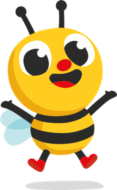My child loves... dinosaurs
Stegosaurus fruit
Make a healthy snack to enjoy with your child and help develop their fine motor skills.

What you will need
- An apple
- Adult knife, a knife your child can safely use and a chopping board
- Cocktail sticks
- Soft fruits such as grapes, melon, banana and strawberries
Safety first
Keep the adult knife out of reach of your child. Ensure that fruit is sliced to an appropriate size so it does not cause a choking hazard. Supervise your child carefully with the cocktail sticks.
What to do
Explain to your child that together you are going to make a snack in the shape of a stegosaurus. Can your child describe what a stegosaurus looks like? Encourage your child to wash their hands and explain why we need to clean our hands before we prepare snacks.
Chop the apple in half and give half to you and half to your child. Put the adult knife away out of reach. Show your child how you can stick the cocktail sticks in the apple so they look like spines of a stegosaurus.
Next, invite your child to choose some soft fruits that they can slice using their knife. When they have chopped their fruit, show them how they can push the fruits down onto the cocktail sticks. When they have finished encourage them to enjoy eating their stegosaurus fruit!
How does this help my child's development?
Preparing food with your child encourages them to have a positive attitude to food. Children are much more likely to try foods that they have prepared themselves. Try doing this experience with different fruits that your child has not tried before such as mango or dragon fruit.
Using real tools such as knives helps children to understand that these have to be used safely and supports them in understanding how to keep themselves safe.
During this experience children will be developing their fine motor skills including bilateral coordination, where your child is using both hands at once to do different things. Good bilateral coordination is an indicator that both sides of the brain are communicating effectively and sharing information.
Dinosaur skeletons
Support your child's fine motor skills and vocabulary development in this dinosaur experience

What you will need
- Cotton buds
- Card or paper
- Chalk, crayons or colouring pencils
Safety first
Supervise your child with the cotton buds
What to do
Invite your child to make dinosaur skeletons using cotton buds. Encourage them to think about which dinosaur skeleton they would like to create, for example a pterodactyl, a tyrannosaurus rex or a stegosaurus. How can they create their dinosaur?
How does this help my child's development?
Picking up and placing the cotton buds helps to develop your child's pincer grip and hand eye coordination, essential skills for later holding and using a pencil
Using dinosaur names develops your child's developing vocabulary. Vocabulary development is an important indicator of a child's overall development.
Dinosaur sort
Help develop your child's classification and sorting skills in this experience

What you will need
- A variety of small world dinosaurs
- Pen and paper
Safety first
No additional considerations
What to do
Show your child the dinosaurs and ask them if they can find any similarities or differences between them. For example, they may be different colours, sizes or patterns. Show your child how they can sort them in a range of ways. For example, on one piece of paper you could write 'large'' and another you could write 'small'. Invite your child to sort them into large and small by placing them on the different pieces of paper.
Next invite your child to sort the dinosaurs by what kind of food they eat, for example 'carnivore' – meat eater, 'omnivore' – eats meat and plants, 'herbivore' – eats plants. Explain that carnivores usually have sharp teeth and herbivores usually have rounded teeth.
You could also find out any dinosaurs that you are not sure about by looking in non fiction books with your child or helping them search on the internet!
How does this help my child's development?
Matching and sorting are important mathematical concepts. To be able to sort, children need to think logically, which is an important skill for later mathematical thinking.
Classifying and sorting is important for developing numerical concepts and the ability to group numbers and sets which will help children with complex sums as they get older.
Activities such as this one are important as they allow children to have hands on experience with classifying and sorting
UP for Educators
UP provides our educators with a wealth of quality learning experiences and essential guidance. UP pushes the boundaries to deliver even better learning outcomes, giving Busy Bees children the very best start in life. There is something on UP for all educators; download UP and see how this can enhance your practice today!








